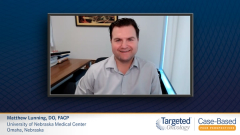
Unmet Needs and Future Directions for Patients with R/R DLBCL
Dr Matthew Lunning closes his discussion on DLBCL by highlighting unmet needs in the treatment landscape.
Episodes in this series

Case Overview: A 64-Year-Old Man with Diffuse Large B-Cell Lymphoma (DLBCL)
Case History
June 2020: A 64-year-old man presented with DLBCL
Stage III disease
ECOG PS 2
Serum LDH=3.7 x ULN
NCCN-IPI score=6 (High-risk)
History of hypertension (well-controlled)
Patient does not harbor MYC, BCL2, or BCL6 rearrangements
July 2020: Patient began treatment with RCHOP (rituximab, cyclophosphamide, doxorubicin, vincristine, prednisone) induction therapy
Patient had neutropenic fever and limiting fatigue that was controlled with growth factor support; also had mild neuropathy
Underwent interim CT scan after 3 cycles/9 weeks and again at completion of therapy (6 cycles/18 weeks)
Patient achieved a metabolic complete response at 18-week PET-CT scan
May 2021: (6 months post–RCHOP completion): the patient complained of recent weight loss, fatigue
Followup CT scan revealed that the patient had relapsed disease
Patient started salvage chemotherapy with R-GemOx (rituximab, gemcitabine, oxaliplatin)
Most Recent Follow-up Notes/Labs
November 2021: 6-month for-cause CT scan and subsequent biopsy revealed that the patient was refractory to GemOx
The patient lives 50 miles from a healthcare facility that administers CAR T-cell therapy and does not have reliable transportation or continuous caregiver support; he and his clinician decided to start 3rd-line tafasitamab/lenalidomide
April 2022: The patient remains on tafasitamab/lenalidomide; fatigue has mostly resolved
Matthew Lunning, DO, FACP: The critical unmet need is that chemotherapy-immunotherapy doesn’t work very well in the relapsed/refractory setting. It may. In those for whom it does work, you have a very narrow window of time to do something with it. If you’re considering and have the opportunity to go to an allogeneic transplant in third-line therapy, if you’re bringing out chemotherapy-immunotherapy, you’ve got to target that disease. You have to be ready to go toward an allogeneic transplant if you get that miraculous complete remission [CR]. Because the odds are that either the bone marrow will give out or the disease will recur if you only keep giving those therapy. Obviously, there are anecdotes of people who have had long-term disease remissions to chemotherapy, but I don’t think that’s the majority.
The discussion about the strategy in the relapsed/refractory setting still needs to be had as the data and the field evolve to dichotomizing people between those who relapsed within 1 year of their end of their initial therapy and those who haven’t relapsed after 1 year of therapy. You need to discuss when you’re going to pull the CAR T-cell card out of the deck. The emergent treatment options are around the bispecific antibodies that engage CD3 and CD20. They appear to have interesting data in the relapsed/refractory setting. Similar to what tafasitamab-lenalidomide brings, if you can get those people into a CR, it has the potential for durability.
Nevertheless, if we’re talking about tafasitamab-lenalidomide, bispecifics, or CAR T cell, we have to look at the populations and compare them with the median PFS [progression-free survival] of those therapies. As we find drugs that as monotherapy or as doublets have efficacy and appear to have the potential for durability, we’re always looking to move them into the frontline setting, where we’re trying to challenge the frontline space. One of the interesting things that’s going to come out is where polatuzumab or CHP [cyclophosphamide, doxorubicin, prednisone] fits in. Where does R-CHOP [rituximab, cyclophosphamide, doxorubicin, vincristine, prednisone] fit in? How do you put all these trials with these novel therapies into that frontline setting? Which regimen do you pair with? Maybe where these regimens are best utilized will become clearer over time.
Transcript edited for clarity.










































